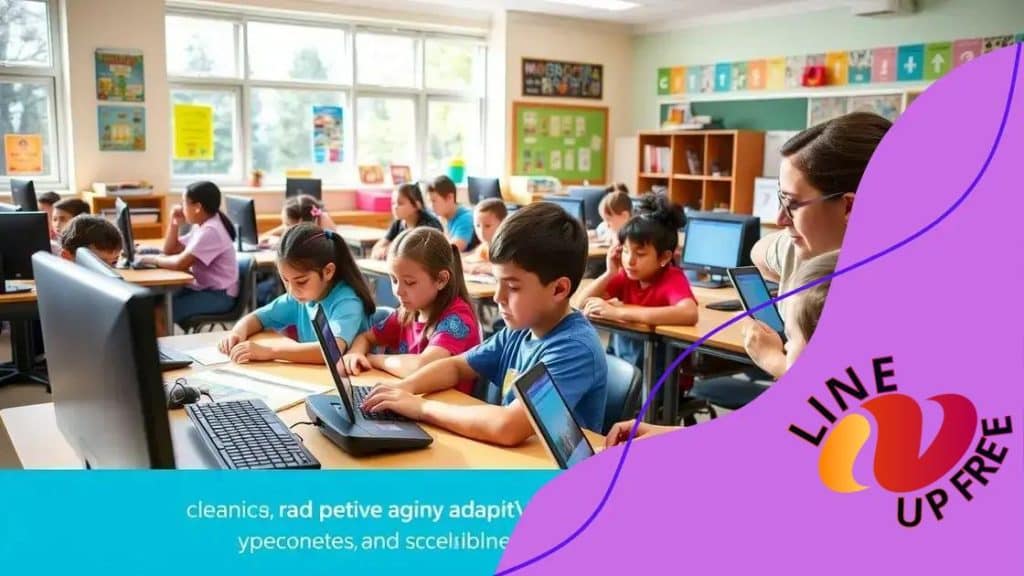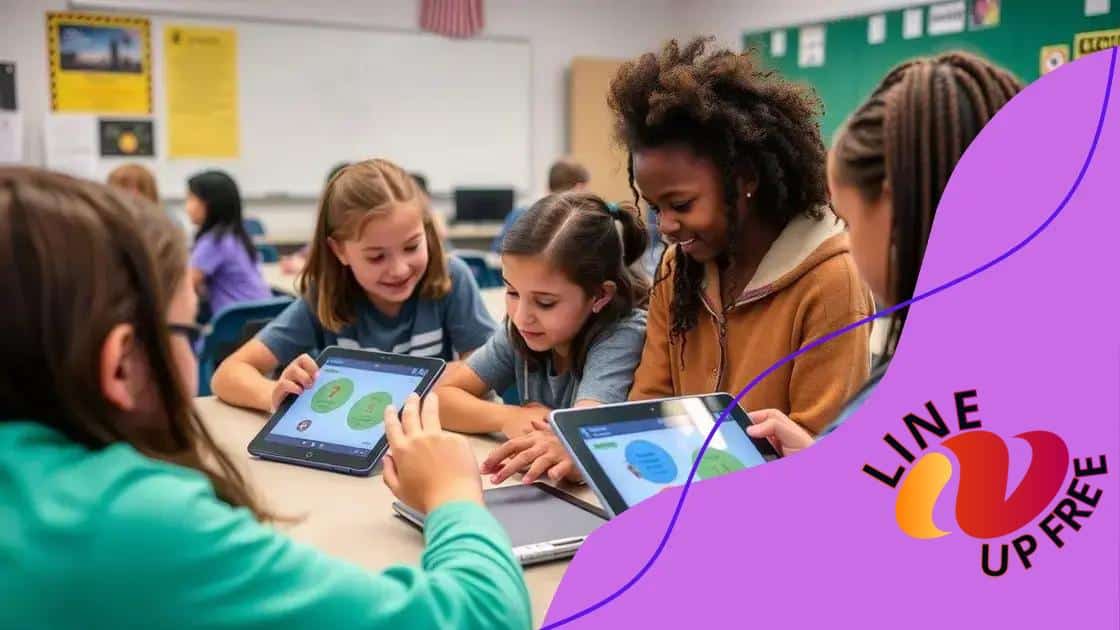The need for inclusive education through adaptive technologies

Anúncios
The need for inclusive education through adaptive technologies highlights the importance of tailoring learning experiences to meet diverse student needs, fostering engagement and success for all learners in a supportive environment.
The need for inclusive education through adaptive technologies is becoming increasingly essential in our diverse classrooms. Have you ever wondered how some tools can make learning accessible for everyone? Let’s dive into this topic!
Anúncios
Understanding inclusive education
Understanding inclusive education is essential for creating supportive learning environments. It involves recognizing and responding to the diverse needs of all students.
Inclusive education means that every child, regardless of their abilities or disabilities, should be allowed to learn together in a shared space. This approach not only benefits children with special needs but also fosters empathy and understanding among all students.
The core principles of inclusive education
There are several key principles that guide inclusive education:
Anúncios
- Equity: Ensuring all students have access to the same opportunities.
- Diversity: Valuing the unique backgrounds and strengths of each child.
- Collaboration: Involving teachers, parents, and communities to support every student’s learning.
By implementing these principles, schools can create an environment where every child feels valued.
In addition to benefits for students, inclusive education also fosters a sense of belonging. When children learn together, they build relationships that transcend differences. This collaboration promotes social skills and can improve academic performance.
Teachers play a crucial role in fostering this inclusive atmosphere. They must be well-trained and equipped to meet diverse needs in the classroom. This includes adapting lesson plans and utilizing appropriate resources.
Tools and resources for inclusive education
Many tools can assist in making education more inclusive:
- Adaptive technologies: Devices and software that assist in learning.
- Specialized teaching strategies: Methods tailored for various learning needs.
- Supportive materials: Resources that address diverse learning styles.
As we explore more about inclusive education, it becomes clear that it’s not merely an approach for special education. It’s fundamental for creating an equitable learning experience for all.
The role of adaptive technologies
The role of adaptive technologies in education is essential for promoting inclusivity. These technologies help all students, especially those with disabilities, to engage in learning effectively.
Adaptive technologies can take many forms, from simple tools to advanced software. Schools use these tools to enhance learning experiences for every child. By understanding how these technologies work, we can better appreciate their importance.
Types of adaptive technologies
There are several types of adaptive technologies that are widely used in educational settings:
- Augmentative and alternative communication (AAC): Devices that help students who have trouble speaking.
- Screen readers: Software that converts text on a screen into spoken words.
- Speech-to-text software: Programs that transcribe spoken words into written text.
- Interactive educational software: Tools designed to adapt to the individual learning pace of each student.
Each of these technologies provides unique support. For example, AAC tools assist students in expressing their thoughts. This opens up communication and fosters social interaction.
Meanwhile, screen readers empower visually impaired students to access written content. This technology has been a game changer, allowing these students to participate equally in classroom activities.
Benefits of adaptive technologies
Using adaptive technologies in classrooms brings numerous benefits:
- Personalized learning: Tools can adjust to meet the needs of each student.
- Increased engagement: Interactive features make learning more appealing.
- Boosted confidence: Students gain independence when using these technologies.
As students gain access to a range of resources, their learning outcomes improve. This is significant for those who might struggle with traditional education methods.
Ultimately, the role of adaptive technologies in inclusive education is profound. They not only assist students in overcoming barriers but also enrich the learning experience for everyone, paving the way for a truly integrated classroom environment.
Benefits of adaptive learning tools

The benefits of adaptive learning tools are numerous and impactful. These tools cater to the individual needs of each student, making learning more effective and engaging.
One of the primary advantages is the ability to provide personalized learning experiences. Adaptive learning tools assess the strengths and weaknesses of students in real-time. This allows educators to tailor lessons, ensuring that every student receives the support they need. By focusing on their specific challenges, students can learn at their own pace.
Key advantages of adaptive learning tools
Some notable benefits include:
- Improved engagement: Interactive content keeps students interested and motivated.
- Enhanced understanding: Students grasp concepts better when materials match their learning styles.
- Immediate feedback: Real-time responses help students correct mistakes as they learn.
- Greater accessibility: Tools can accommodate various learning needs, making education inclusive.
Additionally, adaptive learning tools often use data analytics to track progress. This helps both teachers and students understand growth over time. Teachers can see which areas require more focus, while students can take ownership of their learning journey.
Moreover, these tools can foster collaborative learning. Students can work together, sharing insights and solutions, which enhances their communication skills. This collaborative environment not only promotes academic success but also builds a sense of community among students.
Real-world applications
Many educational institutions incorporate adaptive learning technologies into their curriculums. This includes using software that adjusts questions and activities based on a student’s performance. Schools can also implement personalized learning plans, which utilize these tools!
In conclusion, the benefits of adaptive learning tools extend beyond academic improvement. They create dynamic learning experiences that empower students, making education more relevant and effective for all.
Successful case studies in inclusion
Successful case studies in inclusion provide valuable insights into the impact of inclusive education. These examples demonstrate how adaptive technologies and teaching strategies can transform the learning experience for all students.
For instance, one notable case is a school district that implemented a comprehensive inclusion program. They focused on integrating students with disabilities into general education classrooms. This approach allowed all students to learn together, fostering stronger social interactions among peers.
Case study highlights
A few key highlights from successful case studies include:
- Improved academic performance: Students in inclusive classrooms often show higher achievement levels.
- Enhanced social skills: Students develop empathy and better communication skills through interaction.
- Positive changes in attitudes: Classmates tend to view differences more positively, creating a more accepting environment.
In another case, a specialized training program for teachers led to the incorporation of adaptive technologies in lessons. Teachers learned how to use tools that catered to varied learning styles. As a result, students with learning disabilities were able to access the curriculum more easily.
Moreover, families reported increased satisfaction with their children’s educational experiences. Parent feedback emphasized that children felt more valued and included in school activities. This sense of belonging can significantly boost a child’s motivation and confidence.
Real-world applications
Many schools today are adopting similar methods to ensure all students succeed. By examining these case studies, educators can identify effective practices and strategies. For example, incorporating technology such as assistive devices or personalized learning plans can help tailor education to individual student needs.
Moreover, consistent collaboration among teachers, parents, and specialists in these case studies strengthens the support network for students. This collaborative approach is vital for sustaining inclusive practices and achieving long-term success.
Moving towards a more inclusive future
Moving towards a more inclusive future in education is essential for ensuring that every student has access to quality learning experiences. This shift requires commitment from educators, policymakers, and communities to embrace diversity and implement effective strategies.
One critical aspect of building an inclusive future is the ongoing training of teachers. Educators need to be equipped with skills that allow them to recognize and address the diverse needs of their students. Professional development programs can focus on adaptive teaching methods and the integration of technology in the classroom.
Key steps for achieving inclusion
Several steps can help pave the way for a more inclusive education system:
- Developing inclusive policies: Schools must create policies that promote diversity and equitable access to resources.
- Enhancing accessibility: Classrooms should be equipped with the necessary tools and technologies that cater to all students.
- Encouraging collaboration: Collaboration among teachers, parents, and support staff is crucial for successfully implementing inclusive strategies.
Furthermore, fostering a culture of respect and understanding within schools is vital. Schools can organize workshops and events that celebrate diversity and teach students to appreciate differences. This understanding helps build a supportive environment where every student feels valued.
Another significant step involves leveraging community resources. Partnerships with local organizations can provide additional support and resources for both students and teachers. These partnerships can create mentorship programs, tutoring options, and specialized training for educators.
Looking ahead
As we move forward, technology will play an increasingly important role in creating inclusive classrooms. Innovations in adaptive technologies continue to evolve, offering new possibilities for personalized learning experiences. By integrating these technologies, schools can ensure that students with varying abilities have equal opportunities to succeed.
In essence, moving towards a more inclusive future requires a collaborative effort. By focusing on training, policy development, and community engagement, we can create educational environments that welcome and support every student. This journey is essential for building a brighter, more equitable society for all.
FAQ – Frequently Asked Questions About Inclusive Education and Adaptive Technologies
What is inclusive education?
Inclusive education means providing equal learning opportunities for all students, regardless of their abilities or disabilities.
How do adaptive technologies support learning?
Adaptive technologies customize educational experiences to meet individual student’s needs, helping them engage more effectively in the classroom.
Why is teacher training essential for inclusion?
Ongoing training equips teachers with the skills and strategies necessary to address diverse student needs and implement inclusive practices.
What role does community engagement play in inclusive education?
Community engagement fosters partnerships that provide additional resources and support, enhancing the educational experience for all students.





